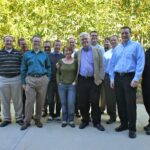|
|
Arista Presents at Tech Field Day 8
In this session, Arista explores its novel network software architecture, Extensible Operating System (EOS), emphasizing its unique design, extensibility, and integration with existing systems. The presentation, led primarily by software engineer Andre Pech and joined by CEO Jayshree Ullal, outlines how EOS allows for flexible, resilient, and developer-accessible network configuration and management. Arista also demonstrates real-world use cases and answers technical questions from industry experts.
Andre Pech begins the presentation by introducing Arista’s Extensible Operating System (EOS), highlighting its architectural design that draws lessons from the Unix paradigm. He emphasizes that EOS is based on an unmodified Linux kernel with separate, independent user-space processes handling different functionalities. Unlike traditional network operating systems that often rely on monolithic kernels susceptible to crashes, Arista’s architecture isolates failures, allowing individual processes to crash and restart independently without bringing down the whole system. This modular design facilitates better resilience, faster upgrades, and easier debugging, fostering a server-like robustness in networking hardware.
A focal point of the presentation is SysDB, Arista’s system database, which functions as the central state repository for EOS. SysDB avoids the need for complex message-passing systems by storing the entire network configuration and status data in a single place. Agents or applications mount parts of SysDB and are notified of relevant state changes. This architecture not only improves modularity and fault tolerance but also enables features such as in-service software upgrades (ISSU) by simply updating and restarting individual processes without interrupting the system’s operation. Pech illustrates this with a live demo involving the Spanning Tree process, showing that killing and restarting it results in no disruptions to forwarding behavior due to state persistence in SysDB.
The session also covers EOS’s extensibility at multiple levels, from native Linux access to scripting with the EOS CLI, and deeper integration through Python APIs that interface directly with SysDB. Pech demonstrates how engineers can use standard Linux tools like bash, TCPdump, and scripting languages to access, monitor, and extend switch functionalities—treating the switch almost like a regular Linux server. One highlight includes a demonstration of using XMPP (Jabber protocol) to create a chat-based interface where switches can exchange information, enabling group-based configuration, real-time queries, and management across the network.
Further discussion explores Arista’s operational tools and partnerships, including integration with VMware ESX through VM Tracer, which dynamically updates VLAN assignments and configurations based on virtual machine movements. Attendees inquire about support for L3 protocols, port mirroring, and debugging capabilities, revealing Arista’s robust feature set tailored for complex data center environments. Pech stresses the focus on open standards and the drive toward features like VXLAN and NVGRE for scalable virtual networking, keeping Arista at the forefront of network virtualization and multi-tenant cloud solutions.
CEO Jayshree Ullal joins the session toward the end to address business and industry trends, explaining how Arista’s strategy aligns with evolving data center needs without vendor lock-in. She emphasizes that the company’s focus remains on best-of-breed, standards-based, software-driven switching. Questions about multi-vendor environments, competition with Cisco and Dell, and future support for technologies like Trill and Fibre Channel over Ethernet are candidly addressed. Ullal insists that Arista’s software-centric approach, combined with transparent pricing and elite support from engineers themselves, positions them uniquely in a crowded networking market poised for next-generation growth.
Personnel: Andre Pech, Jayshree Ullal








